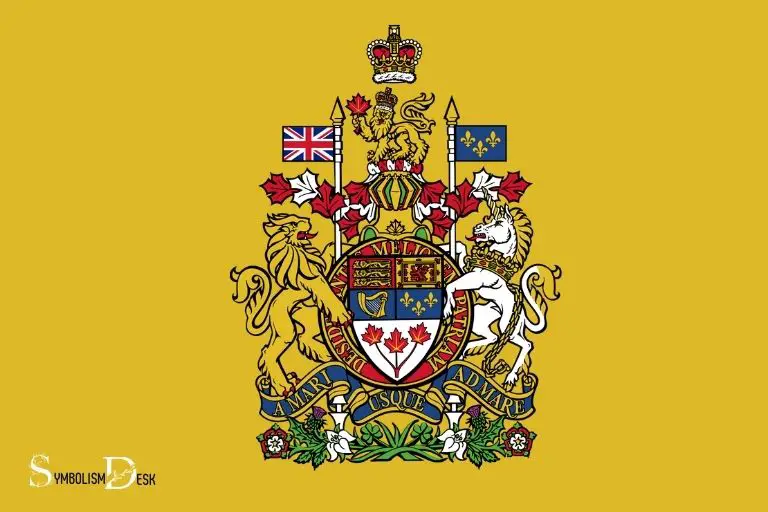Canada Coat of Arms Symbol Meanings: Prestige of the Govt!
The coat of arms of Canada is a symbol of national sovereignty and represents the authority and prestige of the government of Canada.
It consists of many unique symbols, each carrying its own significance. The lion, for instance, signifies bravery and strength, while the unicorn represents purity and strength.
The shield, which combines symbols from England, Ireland, Scotland, and France, represents Canada’s ties to these countries. The maple leaves, a distinct Canadian symbol, signify peace and tranquility.
The Coat of Arms of Canada, also known as the Royal Coat of Arms of Canada or formally as the Arms of Her Majesty The Queen in Right of Canada, was proclaimed by King George V on November 21, 1921.
It consists of a shield in the center, which shows the royal symbols of England, Scotland, Ireland, and France to represent the nation’s historical ties.
The crest above the shield includes a crowned lion, symbolizing courage and bravery. On either side of the shield are the English lion and the Scottish unicorn, denoting Canada’s British heritage.
At the base of the Arms are the symbols of Canada’s two founding nations: red maple leaves and a French royal emblem, the fleur-de-lis.
The Canada Coat of Arms is a symbol deeply rooted in the nation’s history and identity. Its five sections, adorned with golden maple leaves, lions, a fleur-de-lis, and a crowned lion, represent Canada’s unity, British heritage, French influence, and constitutional monarchy.
This emblem succinctly encapsulates Canada’s rich tapestry of culture and history, serving as a proud reminder of its enduring commitment to diversity and democratic principles.
9 Symbols on the Canadian Coat of Arms and Their Meanings
| Symbol | Meaning |
|---|---|
| Crown | Stands for the sovereign nature of Canada |
| Lion Holding a Union Jack | Symbolizes Canada’s ties to the United Kingdom |
| Unicorn | Represents Canada’s relationship with Scotland |
| Royal Helmet | Represents monarchy and the system of government |
| Floral Emblems | Contains red maple leaves, the official national emblem of Canada, and other flowers representing the provinces |
| Shield | Represents the nations that had an impact in Canadian history, including England, Scotland, Ireland, and France |
| Compartment | Features the national floral emblems: the English rose, the Scottish thistle, the Irish shamrock, and the French lily |
| Motto | “A Mari Usque Ad Mare” which means “From Sea to Sea”, signifying Canada’s geography |
| Supporters | The lion and the unicorn supporting the shield, symbolizing Canada’s cultural heritage from both France and the United Kingdom |
Key Takeaway

Five Facts About: Symbols Meanings in the Canada Coat of Arms
Overview Of Canada Coat Of Arms Symbol Meanings
Canada’s coat of arms is a national symbol that evokes a sense of pride and unity among canadians. It represents the country’s heritage, values, and culture. The coat of arms features various emblems, each having its own meaning and significance.
Let’s take a closer look at these symbols and their significance in canadian history.
A Brief Explanation Of Canada Coat Of Arms Symbol
Canada coat of arms is a heraldic emblem that represents the crown’s authority in canada. It comprises several elements: a shield, a helmet, a crest, and several mottoes. The red and white shield is divided into five sections, symbolizing the provinces and territories of canada.
The crest has a lion and a unicorn, representing the british crown. The motto, “a mari usque ad mare” in latin translates to “from sea to sea,” representing the breadth of the country.
The symbolic insignia is authorized by the queen of canada and is a representation of the sovereignty of the canadian state.
The Historical Significance Of The Coat Of Arms Symbol
The creation of canada’s coat of arms symbol is steeped in history. The canadian coat of arms was created in 1921 as a representation of king george v’s authorization of the royal arms of canada.
The various symbols used in the coat of arms represent different aspects of canada’s history and heritage.
- Shield: The red and white bands on the shield represent the original provinces of canada at confederation. The maple leaves in the centre of the shield symbolize canada and its people.
- Crest: The crest features two supporters – a lion (representing england) and a unicorn (representing scotland). They hold a banner that represents the royal union flag and the flag of france, the two cultures that have most influenced canada.
- Motto: The motto “a mari usque ad mare” is latin for “from sea to sea.” It represents canada’s vast territorial expanse, stretching from the atlantic ocean to the pacific.
The canada coat of arms is a symbol of unity and sovereignty. It represents canada’s history and diverse culture. The coat of arms features a shield with symbols from the four founding nations of Canada – England, France, Scotland, and Ireland – which reflects the country’s rich heritage. The motto “A Mari Usque Ad Mare” meaning “From Sea to Sea” underscores the national unity and the vast expanse of the country. Understanding building meanings from the coat of arms helps Canadians to appreciate the significance of their shared history and values.
The various emblems used in the coat of arms symbolize different aspects of canada’s heritage. The creation of the coat of arms is an important part of canada’s history.
It represents the country’s evolution from a colony of great britain to an independent nation with its own symbols of state.
Design Of The Coat Of Arms
Canada’s coat of arms is a symbolic representation of the country’s heritage, values, and aspirations. It comprises intricate design elements that each possess significant meanings.
Understanding the canada coat of arms symbol meanings requires reviewing the detailed design of the canada coat of arms symbol.
Detailed Design Of The Canada Coat Of Arms Symbol
The coat of arms symbol of canada consists of different elements that represent the country’s values, heritage, and aspirations.
These elements include:
Shield
The shield is the most significant element on the coat of arms as it serves as the focal point of the design. The shield has five parts that make up the design, representing the various regions of the country.
These parts symbolize the following areas:
- Upper left: Ontario symbolized by a red cross connected to st. george – the patron saint of england.
- Upper right: Quebec- symbolized by a gold leopard on a blue and white background.
- Lower left: Nova scotia- represented by an image of a blue felt shield with a yellow flower.
- Lower right: New brunswick- symbolized by a green shield adorned with a gold lion.
- Center: The national symbol- a red maple leaf surrounded by two white vertical stripes and two red horizontal stripes on a white background.
Supporters
The shield is flanked by two supporters- a lion and a unicorn- both wearing the crowns of a king, representing england and scotland, respectively. Both symbols reflect an integral part of the country’s history and culture.
Motto
The canadian motto, “a mari usque ad mare,” meaning “from sea to sea,” is inscribed on a ribbon located below the shield, signifying the vastness of the country’s territory.
Crown
The coat of arms is topped by a gold st. edward’s crown, representing canada’s constitutional monarchy and connection to the british monarchy.
Compartment
The base of the coat of arms is the compartment, which is symbolic of the natural resources and beauty of the country. It is made up of green maple leaves and white lilies, the official flower of quebec.
Understanding the meanings behind each element of the coat of arms is essential in understanding canada’s story. The coat of arms is a remarkable representation of canada, its values, culture, and history.
The Shield
The shield is the most recognizable part of the coat of arms of canada, notoriously adorned with numerous symbols representing canada’s history, geography, and culture.
The design of the coat of arms is similar to the royal arms of the united kingdom, marking canada’s longstanding british colonial legacy.
The Meaning Of The Three Lions
The three lions, commonly known as the three lions passant guardant, have a rich history tracing back to the royal arms of england.
They appear twice on the canadian coat of arms: in the top-left quadrant of the shield and on the crown of the queen.
Here are the key points:
- The three lions passant guardant first appeared on the arms of england in 1198 when richard the lionheart introduced them.
- The passant posture in heraldry depicts a lion walking, while guardant means the lion faces the observer.
- The three lions on the coat of arms of canada represent the sovereignty of canada and its association with the british crown.
Explanation Of The Royal Arms Of England
The royal arms of england and canada are similar in design. The main difference is the canadian design has a green maple leaf instead of the st. george’s cross.
Here are the key points:
- Blazoning describes the items on a coat of arms. The blend of the dexter and sinister supporters with the royal arms of england signifies canada’s ties to britain.
- Canada’s coat of arms depicts a woman holding a “torque,” which is an ancient celtic symbol of strength. Her appearance represents canada’s indigenous peoples and their contributions to canadian history.
- The royal arms of england evolved over time, with various monarchs making changes to the design. The current design used on the coat of arms of canada is a combination of designs used at different periods.
The shield on the coat of arms of canada depicts many symbols that reflect canadian history, geography and its ties to britain.
The three lions symbolize the country’s association with the british crown, while the royal arms of england provide insight into the country’s close ties with britain.
The Crest
Canada’s coat of arms is a prominent symbol of the country’s identity, featuring several elements rich with history and significance. One of the most notable parts of the coat of arms is the crest, which is located at the top of the design.
The crest is an ornamental feature that plays an important role in the overall symbolism of the coat of arms. In this section, we will explore two key components of the crest and their meanings: the harp and unicorns.
The Meaning Of The Harp
- The harp is a symbol of ireland and its rich cultural heritage. It was included in canada’s coat of arms as a nod to the country’s irish roots, which date back to the early days of canadian history.
- The harp is also representative of music and harmony, two concepts that are significant to the canadian identity. It is a tribute to the country’s diverse cultural fabric and the importance of unity and collaboration.
- The canadian coat of arms features a gold harp with silver strings on a blue background. This color combination is reminiscent of the irish flag, which also features green, white, and gold.
The Meaning Of The Unicorns
The unicorns that flank the coat of arms are an important symbol of scotland, which has close ties to canada through the large number of scots who settled in the country over the years.
The unicorns also represent nobility and purity, attributes that are celebrated in canadian culture. They serve as a reminder of the importance of integrity and moral strength in all aspects of life.
The two unicorns on either side of the canadian coat of arms support a banner that reads “a mari usque ad mare,” which means “from sea to sea” in latin.
This phrase, taken from psalm 72: 8, is the official motto of canada and speaks to the country’s vast size and diversity, as well as its commitment to unity.
The royal arms of scotland that includes unicorns is an essential part of the canadian coat of arms’ crest.
The overall design reflects the country’s unique history and cultural heritage while also celebrating the ideals of unity, collaboration, and moral strength that are central to the canadian identity.
Motto And Supporters
The canada coat of arms is an important symbol of national identity that defines our nation. The emblem comprises a shield, two supporters, a motto, and a crown. Each of these elements carries meaning that represents canada’s history and values.
Meaning Behind The Latin Motto
The latin motto “a mari usque ad mare” appears on the coat of arms banner, which translates to “from sea to sea. ” The phrase symbolizes the vast expanse of canada from its atlantic to its pacific coasts, representing our country’s geographic enormity.
The motto was first used in canada’s coat of arms in 1921 and has been present ever since.
Explanation Of The Two Supporters
The two supporters of canada’s coat of arms are the lion and the unicorn. The lion represents england, while the unicorn represents scotland.
Both the lion and the unicorn appear on the royal arms of the united kingdom, indicating canada’s connection to the british monarchy. However, beyond symbolism, these animals have specific meanings.
The Lion Supporter
- The lion sits on the left-hand side of the coat of arms adjacent to the maple leaf.
- The lion represents england and its fierce military might, valor, and bravery.
- The image of the lion standing on its hind legs holding a red maple leaf represents canada’s ties to the british monarchy.
- The red maple leaf signifies canada’s national symbol of unity.
The Unicorn Supporter
- The unicorn is opposite the lion on the right-hand side of the shield and is depicted holding a lance and flag.
- The unicorn represents scotland and signifies purity, piety, and courage.
- The lance signifies knighthood’s honour, while the flag symbolizes loyalty and devotion to the crown.
The coat of arms is an essential national symbol that represents canada’s history, identity, and principles.
Each element, from the shield to the supporters, carries meaning and significance. Understanding the various elements of this emblem is crucial in understanding the complexities of canada’s national identity.
Historic And Contemporary Significance
Canada’s coat of arms is a distinct emblem featuring symbols of the country’s history, values, and culture. It represents canada’s heritage and reflects its aspirations and unique identity.
The coat of arms may have an ancient origin, but its modern interpretations remain relevant to canada’s contemporary society.
In this section, we explore the historic and contemporary significance of the canada coat of arms symbol.
Explanation Of The Evolution Of The Coat Of Arms Symbol
- The concept of coat of arms symbol originated in europe during the middle ages, where it was a symbol of a person’s lineage or family.
- In canada, the coat of arms featuring a garter belt and a white unicorn first appeared in the 17th century, representing the british monarch’s claim to the territory.
- The canadian coat of arms symbol as we know it today was officially introduced in 1921, showcasing the country’s flora, fauna, and diverse cultures.
- The shield has four quadrants, each representing an aspect of canada’s geographical and cultural landscape: French and english heritage, indigenous peoples, agriculture, and natural resources.
Current Relevance And Use Of The Coat Of Arms Symbol
- The coat of arms symbol is an essential element of official state documents and government representation activities, including the passports, currency, and flags.
- It appears on numerous federal, provincial, and territorial buildings, legislative assemblies, and other official structures, representing various levels of government.
- The coat of arms symbol’s imagery is used in public celebrations, national holidays, and other civic events, reflecting the country’s values of inclusiveness, diversity, and unity.
- The coat of arms symbol does not only represent canada’s past but also its present and future aspirations, including the promise of freedom, democracy, and prosperity.
Canada’s coat of arms symbol is more than a historical artifact. It is a living emblem that conveys the country’s unique identity and aspirations.
The evolution of the emblem over the centuries reflects its versatility and resilience, enabling it to remain a symbol of canada’s heritage and contemporary identity.
Other Canadian Symbols
Canada is proud of its rich cultural heritage, and its coat of arms is steeped in history and tradition. The coat of arms is an integral part of canada’s identity, but it is not the only symbol that represents this great country.
There are other symbols that hold significant meaning for canadians and represent the country’s values, history, and diverse culture.
In this section, let us explore the meaning behind some of these other canadian symbols and compare them with the canada coat of arms symbol.
Comparison Of The Canada Coat Of Arms Symbol With Other Canadian Icons:
The canadian flag: The canadian flag is the most recognizable symbol of canada, with its iconic red and white stripes and a red maple leaf in the center.
While the canada coat of arms symbol contains more detailed imagery, the flag’s simplicity and boldness make it instantly recognizable.
The beaver: The beaver has long been associated with canada and is often referred to as the “national animal.” The canada coat of arms symbol includes two beavers as part of the design, representing the importance of this animal in the country’s early history and fur trade.
The maple leaf: The maple leaf is a symbol of canada known for its beauty and vibrant colors. It is represented in the canada coat of arms symbol alongside the other images, but it has taken on a symbolic meaning all its own.
The maple leaf is a representation of canadian unity, as it is a symbol that resonates with all canadians regardless of their background.
The inuksuk: The inuksuk is an iconic figure in canadian culture that represents the inuit people’s resourcefulness and navigational expertise.
The canada coat of arms symbol does not feature the inuksuk, but it is still an essential symbol of canadian identity and represents the country’s diverse cultural heritage.
The hockey stick: Hockey is one of canada’s most popular sports, and the hockey stick has become a symbol of the country’s love for the game.
While it may not be as recognizable as the beaver or the maple leaf, the hockey stick holds a special place in canadian culture and reflects the country’s love for sports.
The canada coat of arms symbol may be the most well-known canadian symbol, but it is not the only one that represents this great country.
Each of these symbols holds a unique meaning for canadians and represents the country’s diverse cultural heritage.
FAQ About Canada Coat Of Arms Symbol Meanings
What Is The Canada Coat Of Arms?
The coat of arms is a symbolic representation of canada’s identity and sovereignty.
What Are The Symbols On The Canada Coat Of Arms?
The coat of arms features several symbols, including the maple leaf, lion, unicorn, and crowned harp.
What Does The Crown On The Canada Coat Of Arms Represent?
The crown on the coat of arms symbolizes the monarchy and canada’s ties to the british commonwealth.
What Is The Motto On The Canada Coat Of Arms?
The motto on the coat of arms is “a mari usque ad mare,” meaning “from sea to sea. “
Why Was The Canada Coat Of Arms Created?
The coat of arms was created in 1921 to represent canada and its unique identity as a sovereign nation.
Conclusion
After analyzing and discussing the canada coat of arms symbol meanings, it becomes evident that there is much more to the design than meets the eye.
Every element of the coat of arms has been carefully chosen to represent the values, history, and cultural significance of canada.
The imagery of lions, unicorns, maple leaves, and motto “a mari usque ad mare” are all elements that come together to create the identity of what it means to be canadian.
As we have seen, the canadian coat of arms is more than just a mere symbol; it is a representation of the country’s vast and complex history, reflecting the resilience, strength, and diversity of its people.
The coat of arms provides a visual representation of canada’s identity and serves as a reminder of what makes canada truly unique.
Through its timeless design and symbolism, the canadian coat of arms will continue to inspire and unite canadians for generations to come.






